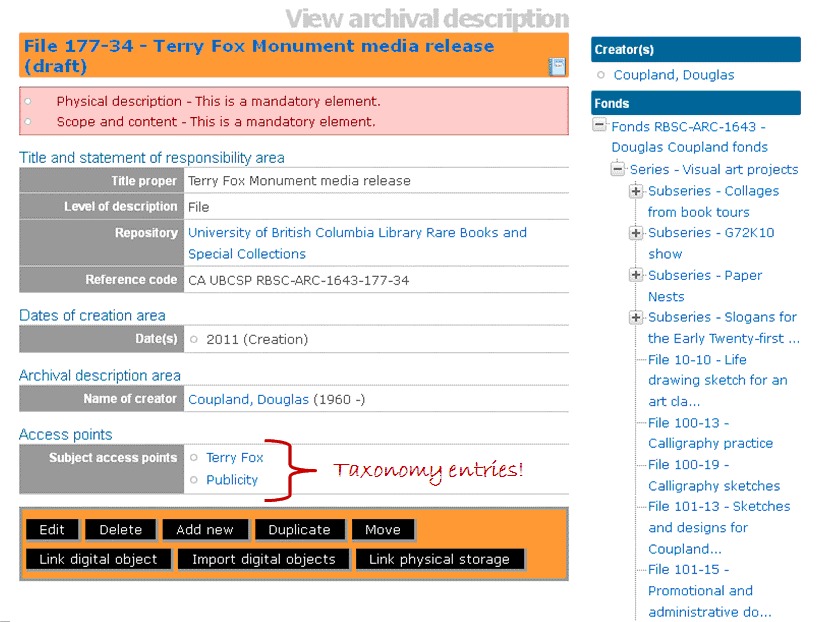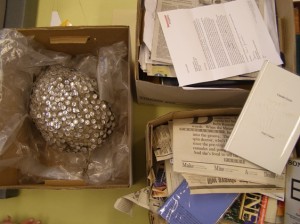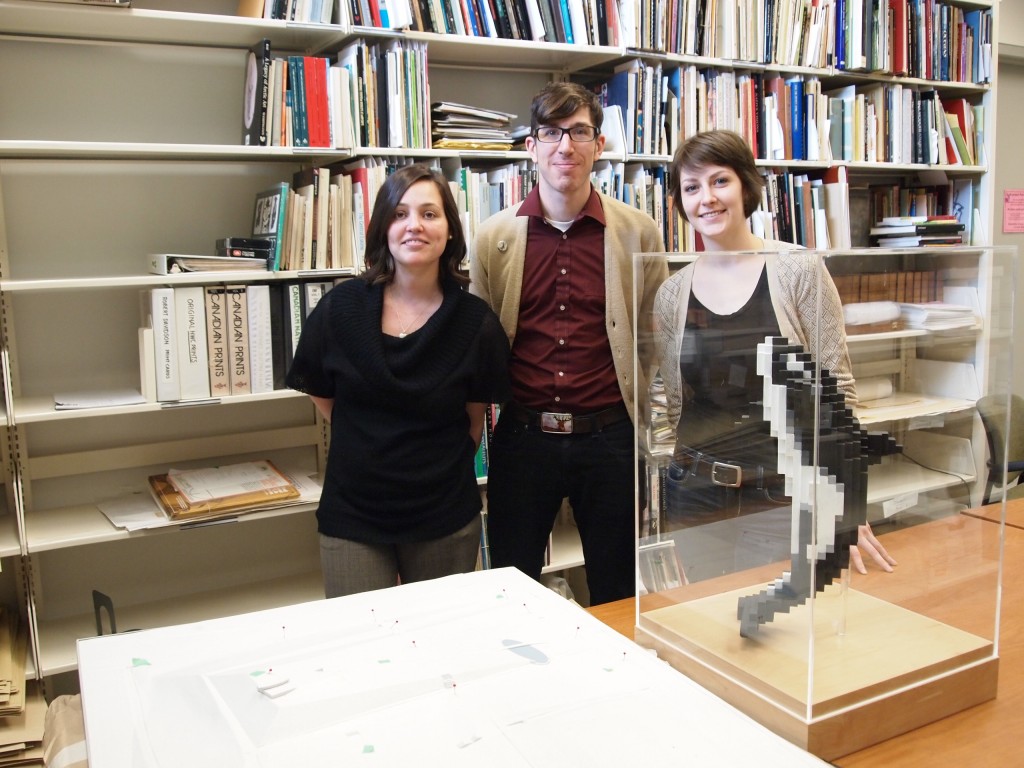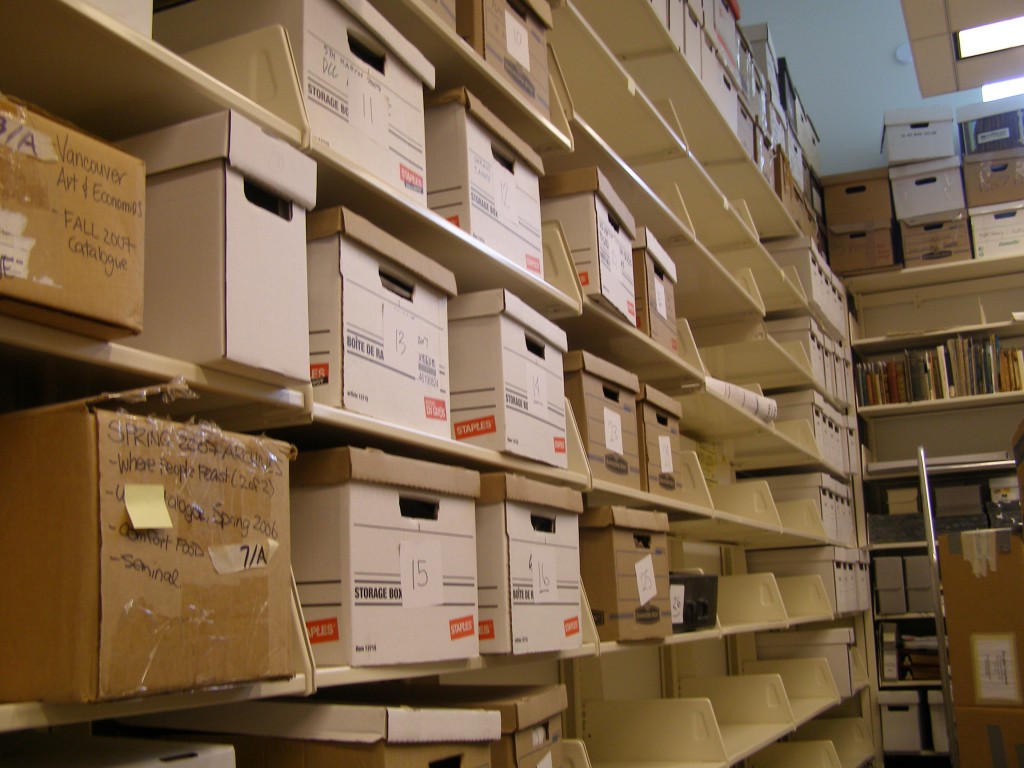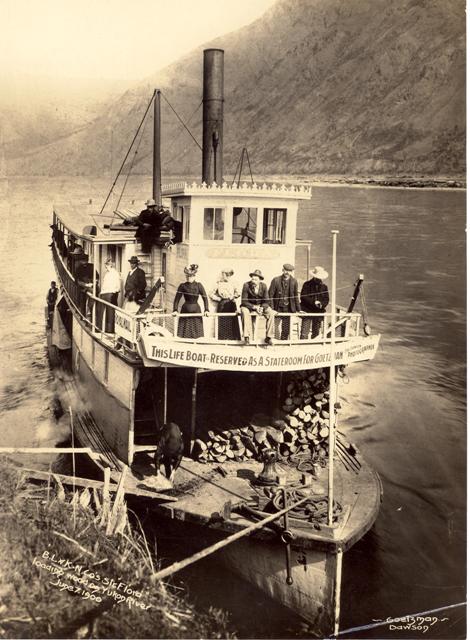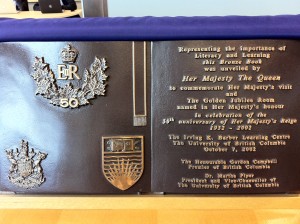B.C. Day Closure
Posted on August 3, 2012 @10:34 am by sromkey
A reminder that Rare Books and Special Collections, University Archives and the Chung Collection will be closed on Monday August 6th for B.C. Day, along with all other branches of UBC Library.
If you will be spending your long weekend watching the Olympic games, you might be interested to know that Rare Books and Special Collection holds the archives of former Olympian Harold Wright. He represented Canada in the 1932 Olympics in Los Angeles as a sprinter, reaching the semi-finals in the 100 and 200 m races. He went on to become the president of the Canadian Olympic Association, and would play a key role in bringing the summer Olympics to Montreal in 1976. Wright passed away in 1997, and was inducted into Canada’s Sports Hall of Fame in 1987. His archives contains a great deal of textual documents and ephemera related to sporting in B.C. and Canada, especially the Olympic games. There catalogue record for the collection is here; click on the inventory link for a detailed finding aid.
No CommentsPosted in Announcements, Services, Uncategorized | Tagged with
Secret Wisdom of the West Coast: Esoteric and Occult practice in British Columbia
Posted on December 22, 2022 @12:36 pm by kalsbeek
From August 1-31, 2012 please visit UBC’s Rare Books and Special Collections exhibition entitled Secret Wisdom of the West Coast: Esoteric and Occult practice in British Columbia. Curated by Karen Meijer-Kline, a graduate of the Universiteit van Amsterdam with a Master of Arts degree in Mysticism & Western Esotericism and a current student in the Masters of Library, Archival, and Informations Studies program at UBC, this exhibition will introduce you to a world many of you probably never dreamed existed here in our very own rainy city.
The historical and sociological study of esotericism and occultism is a growing field, as is shown by the emergence of academic programs, conferences and journals focussed on the subject all over the Western world. Close to home, Simon Fraser University’s department of Humanities has recently offered a course on the history of Western Esotericism. Study in this field looks at topics such as magic, alchemy, astrology, Rosicrucianism, Kabbalah, Freemasonry, Theosophy, Spiritualism, New Age, Neopaganism, and the like. These topics, and the people that studied and practiced them, have been and are very influential in history, even though in the past they have been rarely studied. Here at Rare Books and Special Collections, we realized that there are many works in our collection that are related to these topics, and yet: almost no-one knows about them. We decided to delve deeper into the history and practice of esoteric currents in British Columbia, in order to show you some of the very intriguing things that have happened, and still happen in our province!
For many years, Vancouver has been home to several prominent figures in esoteric history, and centre for many esoteric and occult groups. For example, the North Shore was home to Charles Stansfeld Jones, better known as Frater Achad, who was considered the magical child of Aleister Crowley: the most notorious magician of the 20th century. Jones and Malcolm Lowry were friends, and Lowry’s personal library held many fascinating esoteric works, many by Jones or Crowley.
On display at Rare Books and Special Collections will be works that are fundamental to esoteric thought, and esoteric works that have an interesting connection to major figures or organizations in British Columbia. Many might know that Malcolm Lowry had a long standing interest in the occult, and that Robin Skelton was a practicing witch. But did you also know that Alexander Maitland Stephens, the prominent Marxist and poet, was the head of a Theosophical lodge in downtown Vancouver? That there was a Rosicrucian temple in Vancouver? Or that there have been thriving Freemasonic lodges in British Columbia since 1860?
If you would like to see the exhibition, located in the reading room, you can do so until August 31st, from Monday to Friday 10am-4pm. The exhibition is free and open to all members of the public.
If you are unable to visit the exhibition, a pdf version of the exhibition guide is available.
2 CommentsPosted in Exhibitions, Uncategorized | Tagged with
Unpacking the Douglas Coupland fonds: taxonomies and tagging
Posted on July 31, 2012 @11:21 am by sromkey
Archivists note: This week our student archivists are going to explain how taxonomies, which is like “tagging” only slightly more sophisticated, is helping them draw out important connections in the Douglas Coupland fonds. It does make me reflect on how the technology we use to catalogue (or arrange and describe, in archives jargon) can affect both the process of arrangement and description, and how the information is displayed to our users. As our student archivists describe below, we at Rare Books and Special Collections are in the process of moving our finding aids into a database system called ICA-Atom. With more, our student team:
A word on taxonomies…
Taxono-what? Ok – so this is library and archives jargon, but if you’re familiar with tagging (who hasn’t tagged a photo on facebook or flickr?) the concept of taxonomies is the same – the only difference being that our “tags” can be organized hierarchically, with broader terms, narrower terms, and related terms. For example, the tag “JPod” could be a narrower term of “literary projects”, and could also have narrower terms to distinguish between the television adaptation script, the drafts, and the final manuscript.
Last post we talked about the challenges in organizing Coupland’s wide variety of materials into an order that maintains a link to how we received the materials, but also organizes them in a way that makes the fonds accessible and understandable to users. Since we have decided to process the materials in the order received, how then will researchers be able to see the relationships between items? Our solution: taxonomies!
Here at RBSC, we are also in the process of migrating our descriptions to a new platform called ICA-AtoM that allows for the use of tags and web-based navigation. ICA-AtoM is an open-source, web-based archival description software that is based on International Council on Archives (ICA) standards, freely available to users (and created by a graduate of UBC’s School of Library, Archival, and Information Studies!). In addition to a lot of other great features, ICA-AtoM also includes a taxonomy module, that will allow us to use a controlled vocabulary of tags when processing the newest Coupland materials.
So how will we go about doing this? First, we’ve created a subject list in ICA-AtoM based on the contents of Douglas Coupland’s material. For example, we have “tags” called Generation A and Girlfriend in a Coma that will be used for all files related to these two literary projects. Collage and Calligraphy are two more that will be used for materials related to some of Coupland’s visual art projects. Clicking on a taxonomy word within ICA-AtoM will reveal all other files related to the same subject. The taxonomy, then, is another avenue of access that patrons can use in addition to the finding aid/file list to find what they’re looking for. Because we are still in the process of figuring out all the projects and subjects covered in this accrual to the Coupland fonds, we are also creating tags “on the fly” as we work; once we’ve finished the initial process and are working on updating the series-level descriptions, we’ll also be managing the hierarchical relationships between the tags, so relationships between tags are maintained as well. This way, if a patron wants to see everything we’ve added about say, Coupland’s Firefighter’s Memorial in Ottawa, they can search the term “Firefighter Memorial” and all the related records will appear. Further, any of these records will have a tag-link included in the description to all the other related records, as well as listing any other related tags.
We’re excited to be implementing the first use of taxonomies here at RBSC, and we’ll be sure to update you on our progress as we carry on!
No CommentsPosted in Collections, Research and learning, Uncategorized | Tagged with Coupland
Unpacking the Douglas Coupland fonds, part 2: order and disorder
Posted on July 25, 2012 @7:21 am by sromkey
Archivist’s note: When you tell people you’re an archivist, they often assume that we spend a lot of time meticulously re-organizing documents into some kind of “correct” order. This is a misconception- as our student archivists will describe below, maintaining original order is actually an important tenet of archival theory and practice. Here are Dan, Laura and Sarah with more:
Perhaps you are wondering what it is we (student) archivists do when a new set of boxes is delivered? What actually goes on in that processing room? And why is it important? If these questions are keeping you up at night, read on for a look at the first step in processing a new accrual….
The first challenge we faced with the Douglas Coupland project was figuring out how to arrange the material. We can’t just dump it into acid-free boxes and call it day! One of the fundamental principles of archival work is respect for original order. This states that records should be organized in the order established or intended by the creator. So no alphabetizing! No rearranging by date!
Why is original order important? In a nutshell, it preserves the relationships between records and any evidence that could be gleaned from those relationships. Context is key.
Determining original order isn’t always easy. Sometimes the intended order gets jumbled before or during the transfer of the material to the archives. Other times, if the creator had no system of arranging their own records, there is no original order. In the case of the former, archivists would spend some time analyzing the material in order to restore the original order. In the latter, archivists could impose an order to facilitate arrangement, description, and access.
Our first order of business was to survey the material in an attempt to discern the original order. This proved difficult. Why? Each box of material appeared to be a veritable mishmash of non-related items. Manuscripts next to a hornet’s nest next to doodles next to fan mail. At first, we thought it might be necessary to impose an order by arranging the material by artistic medium. Upon closer examination and reflection, we could not be sure there wasn’t significance to the apparent random nature of the material. Because we were concerned we would break important archival bonds if we physically (re)arranged the material, we came up with the following solution:
- process the material according to received order (right down to the individual movie ticket stubs)
- using ICA-AtoM (an open-source archival description software), intellectually arrange the material into series based on artistic medium without physically disrupting the physical order
- create a taxonomy within ICA-AtoM to link materials to other related materials
Curious to find out what a taxonomy is? Stay tuned for our next exciting blog post to find out!
1 CommentPosted in Collections, Research and learning, Uncategorized | Tagged with Coupland
Unpacking the Douglas Coupland fonds: a new acquisition and a new project
Posted on July 18, 2012 @3:58 pm by sromkey
We’re very pleased to announce a recent addition (or accrual to use archival language) to the archives of Douglas Coupland (or the Douglas Coupland fonds, again to use the archival terminology). We have been very fortunate to continue our relationship with Doug Coupland since we first acquired his archives in 2008, but for the first time we have decided to shine a light on what happens to archival material between coming in the doors and being made available to users in the reading room. We think it’s particularly interesting and exciting to do this with the Douglas Coupland fonds because of the wide range of documentation he creates.
We’re fortunate also to have three student archivists jointly handling this project over the summer: Dan Gillean, Laura Hebert and Sarah Hillier are all students from the School of Library, Archival and Information Studies. They will be writing posts on this blog every week or so to keep you updated on their progress. You can see all of our posts on this project by browsing for the Coupland tag on our blog.
Without further adieu, our student archivists:
“On Thursday, June 21st a large shipment of banker’s boxes and strangely shaped packages arrived at UBC Rare Books and Special Collections. The twenty-six pieces comprise the recent accrual to the already substantial Douglas Coupland fonds. Because of Coupland’s varied range of medium (and we mean varied – everything from large-scale sculptures to screenplays to clothing lines) the contents of these boxes present many unique questions from the archival perspective.
“So how to tackle such a diverse accumulation of content? We have been tasked with the arrangement and description of this material and hope to collaboratively produce a clear picture of Coupland’s creative process through our treatment of the accrual. A little about us…
“Dan Gillean – MAS/MLIS Student at SLAIS, entering 3rd year
I’ve been working as a Student Archival Assistant since September of 2011, processing a large accrual from the provincial New Democratic Party. I’m particularly interested in the arrangement challenges we will encounter with this project – for example, how will we know if that flattened box of macaroni was meant for a collage, used in one of the Canada photographs, or kept as a reference item for one of his many narrative projects? What if the answer is all three? More importantly, how can we best indicate these linkages and conjectures to our patrons at RBSC?
“Laura Hebert – MAS/MLIS Student at SLAIS, entering 3rd year
I began my work as a Student Archive Assistant at RBSC just over a year ago. In my time here I have worked on the processing of a number of fonds and collections, both of a personal and organizational nature. Of particular interest to me are the items in this accrual that are atypical in terms of what we see in Special Collections. What are the best ways to treat these items that are so far from the textual record and how can we effectively communicate their context?
“Sarah Hillier – MAS/MLIS Student at SLAIS, entering 3rd year
I started working at RBSC as a Student Archives Assistant about a year ago. Most recently I’ve worked on the arrangement and description of a new accrual to the Arsenal Pulp Press fonds. Of interest to me regarding the Douglas Coupland fonds is tackling the challenges associated with the proper storage and preservation of non-traditional archival materials, i.e. a bejeweled hornet’s nest, a digital orca, and a styrofoam leg
“Influenced by Coupland’s own fondness for the blog format, we will chronicle our journey here. Follow our progress as we unpack the work of the prolific writer and artist.”
1 CommentPosted in Announcements, Collections, Research and learning, Uncategorized | Tagged with Coupland
Canada Day closure
Posted on June 29, 2012 @12:25 pm by sromkey
A reminder that like all UBC Library branches, Rare Books and Special Collections, University Archives and the Chung Collection will be closed in lieu of Canada Day on Monday July 2. We will resume normal hours on Tuesday July 3.
The photograph above is attributed to Phillip Timms and probably was taken near the turn of the 20th century. According to the inscription, this photograph was taken at the Dominion Day Parade at the corner of Georgia and Burrard. The parade float is likely a reference to the famous Vancouver City Hall tent, erected and photographed after the great fire of 1886 (see it at the City of Vancouver Archives here).
This photograph is from our B.C. Historical Photograph Collection. For more information on searching and using photographs, please see our Historical Photographs Research Guide. When searching for historic Canada Day celebrations, remember to also search for “Dominion Day-” the name of the holiday was not changed until 1982- see Canada Day Background from Canadian Heritage.
No CommentsPosted in Announcements, Collections, Uncategorized | Tagged with
Featured place: Yukon
Posted on June 5, 2012 @9:27 am by sromkey
I am headed off this week to the Association of Canadian Archivists conference in Whitehorse, so it seemed appropriate to feature the Yukon Room in our ongoing blog series on places used as room names in the Irving K. Barber Learning Centre. The theme of the conference is “In Search for Archival Gold,” and archivists from across the country will be there to discuss how to acquire, appraise, preserve and provide access to the “gold” in our collections. Aside from rooms named after people or events, the Yukon room is the only room in the Barber Centre that is not named after a B.C. place. Coincidentally, although Rare Books and Special Collections focuses primarily on the history of British Columbia, to a certain extent our collections policy does include the Yukon and the Arctic (you can read our full collection policy online here).
The item we would like to feature from our collections about the Yukon is a photograph of a steamship named the Flora, shown loading wood on the Yukon River:
The photographer’s inscription reads, “B.L. and K.N. Co.’s str. “Flora” loading wood on Yukon River, June 7, 1900,” meaning “Bennett Lake and Klondike Navigation Company Steamer.” The photographer, H.J. Goetzman, according to Camera Workers of B.C. was active in the Dawson area from ca. 1897, and then moved on to San Fransisco in 1904, putting him in the Yukon for the Klondike Gold Rush. Goeztman was obviously a frequent passenger on the Flora– as you can see in the photo, the lifeboat is declared as “Reserved as a stateroom for Goeztman, Dawson Photographer”!
Supposing you wanted to do some research about the Flora– if you search online, you will find that Wikipedia lists it in an article about Steamships of the Yukon River. But since the information about the Flora is not cited specifically, it is difficult to know whether you can trust that information. To research ships, we often point researchers to either the Vancouver Maritime Museum Library and Archives, where they have access to Lloyd’s Register of Ships. You could use the information in the Wikipedia article as your starting point, but confirm it (and maybe dig a little deeper) using primary sources.
This photograph is part of our general B.C. Historical Photograph Collection (kind of a misnomer since this photo isn’t from B.C.!); you can read more about our photo collections in our Historical Photographs Research Guide.
In the Barber Centre, the Yukon Room is number 181, a classroom on the first floor.
No Comments
Posted in Collections, Research and learning, Uncategorized | Tagged with
Featured place: Ucluelet
Posted on May 26, 2012 @11:42 am by sromkey
This post is part of a series which uses the room names in the Irving K. Barber Learning Centre to explore places in B.C. and the collections at Rare Books and Special Collections. Our featured place for this post is Ucluelet, located on the west coast of Vancouver Island. Ucluelet is located on the edge of Barkley Sound and is known for being at the southern end of beautiful Long Beach, which is in between there and Tofino. The Ucluelet area is home to the Yuułuʔiłʔatḥ First Nation.
The resource from our collections we would like to feature from Ucluelet is a pamphlet describing land available for preemption in 1914:
This pamphlet was issued by the B.C. Minister of Lands (William R. Ross) and describes the geography, climate and settlers of the Ucluelet Peninsula. It explains that 40-acre lots would become available for preemption on June 15, 1914 and also provides a map of the lots available:
As explained by the B.C. Archives, the preemption of lands was allowed so that individuals and corporations could acquire crown land, with the idea that they would cultivate it or otherwise “improve” it. This was in practice from 1859 until 1970 in B.C. The B.C. Archives link above describes how to search for a preemption record; they are now often used as genealogical sources. You can search an online database by name, district, date and other parameters. For example, you could search for lands granted in the Clayoquot District (which would include the lots described in this pamphlet in Ucluelet) from June 15 1914 till the end of that year to get a sense of how many of these lots were preempted, and to whom.
This pamphlet is part of our SPAM (Special Collections Pamphlet collection) and can be found by searching in the Library Catalogue. For information on this collection and other ephemera in our collections, check out our Ephemera Research Guide.
In the Barber Centre, the Ucluelet Room is room 158, a classroom on the first floor.
No CommentsPosted in Collections, Research and learning, Uncategorized | Tagged with
National Archival Development Program cut this week
Posted on May 4, 2012 @12:29 pm by sromkey
We were shocked and saddened this week to learn of the cancellation of the National Archival Development Program. This is in addition to a major round of cuts at Library and Archives Canada, which was the funding source of the program.
The funding is used by the Archives Association of British Columbia, as it is in other provinces and territories by their respective archival organizations, to maintain our provincial database of archival holdings, MemoryBC, and to employ a professional archivist and a professional conservator to provide advice to archival institutions and archivists when needed. It also provides professional development opportunities for archivists, so that we can continue to learn to serve our patrons and our collections better. UBC Rare Books and Special Collections has very frequently taken advantage of these opportunities; for example, this program was used to help develop a preservation plan for the Chung Collection, a declared national treasure and one of our most frequently used collections.
This same pot of funds was used to maintain the national archival database, Archives Canada. This database brings together archival descriptions from institutions across Canada. There is no other “one stop shop” for searching archives across the country, making this and provincial/territorial equivalents like MemoryBC absolutely crucial research tools for everybody who uses archives. In our reference and teaching activities here at RBSC, we are constantly referring researchers to these resources.
The other arm of this funding was used to provide matching grants to archival institutions to preserve, catalogue and disseminate our archival collections. In recent years, this funding was used by Rare Books and Special Collections to catalogue and make available the Mike Apsey fonds, the Council of Forest Industries fonds, and the Red Cedar Shingle and Handsplit Shake Bureau fonds (all in our recently created Forest History research guide); the Jack and Doris Shadbolt fonds (featured in our British Columbian Art and Artists research guide); and the Rosemary Brown fonds (the archives of the first black female member of a Canadian parliamentary body). Just from these examples, it is easy to see that this funding is crucial in helping the Canadian public gain access to records ranging from industry, to politics, to the environment, to the arts.

Advertisement from the Red Cedar and Handsplit Shake Bureau fonds, preserved and catalogued using NADP funds
The National Archival Development Program was administered by the Canadian Council of Archives. If you would like to learn more, there is a Call to Action on their website.
1 CommentPosted in Collections, Research and learning, Services, Uncategorized | Tagged with
Featured room: Golden Jubilee Room
Posted on April 17, 2012 @1:14 pm by sromkey
In 2002, Queen Elizabeth II became the second-longest reigning monarch in British history, celebrating 50 years on the British throne. Despite the deaths of her sister, Princess Margaret and her mother, Queen Elizabeth, the Queen Mother, in February and March of 2002 respectively, Queen Elizabeth II and her husband, Prince Phillip, undertook an international tour in which she “express[ed] her thanks to people, both personally and officially, for their support and loyalty over her reign.”
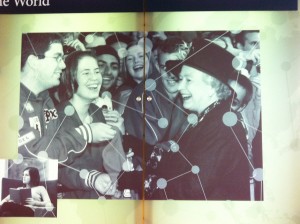
Image of Queen Elizabeth II greeting UBC students in 2002, featured on the commemoration wall in the Golden Jubilee Room
For more information on Queen Elizabeth II and Prince Phillip’s tour, please refer to the official website of the British Monarchy, where the details of the 2002 tour are discussed.
As part of that tour, Queen Elizabeth and Prince Phillip visited the University of British Columbia in October, 2002. They had visited Canada the campus three times before, in 1951, 1959 and 1983. To view digitized photographs of their previous visits, please take a look at the University Archives virtual display, Royal Visits to the UBC Campus
During her 2002 visit to UBC, the Queen unveiled a plaque commemorating her visit and celebrating the naming of a room on the fourth floor of the Irving K Barber Learning Centre, the Golden Jubilee Room.
This room is a very popular study space, with mountain and ocean views.
No Comments
Posted in Collections, Uncategorized | Tagged with

